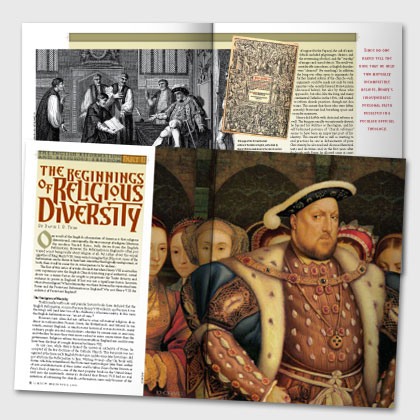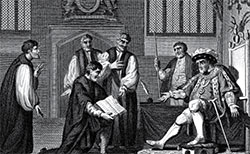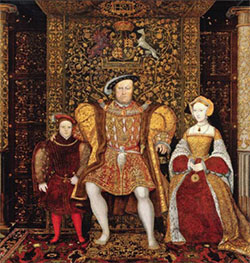The Beginnings of Religious Diversity
David J. B. Trim March/April 2009
This article is Part Two in a four part series. Click here for Part One, here for Part Three, and here for Part Four.
One result of the English colonization of America is that religious diversity and, consequently, the very concept of religious liberty in the modern United States, both derive from the English Reformation. However, the Reformation in England is often portrayed as not being really about religion at all, but rather about the sexual appetites of King Henry VIII. Some seem to imagine that if the root causes of the Reformation can be shown to have been unworthy, theologically unimportant, or both, then it will be easier for its consequences to be undone.
The first of this series of articles showed that when Henry VIII asserted his own supremacy over the English Church (rejecting papal authority), carnal desire was a minor factor; he sought to perpetuate the Tudor dynasty and enhance its power in England. If lust was not a significant factor, however, what about religion? What relationship was there between the separation from Rome and the Protestant Reformation in England? Was not Henry VIII the architect of Protestant England?

Henry VIII being presented with Cranmer's Bible, the first authorized edition of the Bible in English
The Emergence of Diversity
Traditionally, textbooks and popular history books have declared that the English Reformation occurred because Henry VIII willed it; and because it was the king’s will (and later two of his children’s), it became reality. In this view, the English Reformation was “an act of state.”1
However, laws alone did not suffice to erase substantial religious dissidence in early-modern France, Savoy, the Netherlands, and Ireland. In sixteenth-century England, as much recent historical research reveals, many ordinary people resisted royal policies, whether by commission or omission, and whether because they were more radical or more conservative than the government. Religious reform was not inevitable in England nor could it ever have been the fruit of a single decision by Henry VIII.
In any case, while Henry denied the universal authority of Rome, he accepted all the key doctrines of the Catholic Church. This key point was recognized at the time; early English Protestants, unlike some later historians, did not attribute the Reformation to him. Writing 30 years after the break with Rome, which he remembered, the Protestant martyrologist John Foxe, author of Acts and Monuments of these Latter and Perillous Dayes (better known as Foxe’s Book of Martyrs—one of the most popular books in the United States well into the nineteenth century), declared that Henry VIII had no real intention of reforming the church—reformation came only because of the godly character of Henry’s son, Edward VI, and daughter, Elizabeth I.
Henry did institute some reforms of the English Church, but they were very moderate and he rejected Protestantism until his death. It must also be stressed that he utterly rejected any notion of religious liberty. Indeed, under Henry for the first time religious dissidence could be treated as treason, as well as heresy; the Henrician religious regime thus was actually more repressive than that of the medieval church.
Despite this, a range of dissident religious movements took root in England during the final third of his reign. Those English people who retained a deep attachment to the Roman Church were one of the persecuted “sects,” but there were also various groups interested in the ideas of Martin Luther, Huldrych Zwingli, Heinrich Bullinger, Martin Bucer, John Calvin, and the Anabaptists. Even many people who accepted most of the doctrines and practices of Henry’s church might be at least interested in one or two heterodox ideas. England in his father’s reign had been judged by foreign visitors to be one of the most devout countries in Latin Christendom; in the mid-1520s it was a still stronghold of the Roman Catholic Church. By the late 1540s, England was not yet Protestant, but heterodox opinion flourished where once there had been near uniformity.
This was not Henry VIII’s intention, nor was England’s substantive transformation in the decades after his death. But we can see today that the emergence of heterodoxy was the beginnings of the English Reformation.
Henry VIII and Reform
If it was not Henry’s intention, then how did it happen? Although it was not clear at the time, with the benefit of hindsight we can see that a kind of foundation had been laid in the second half of Henry’s reign by the moderate reforms of Henry and some of his ministers, and by the emergence of heterodox groups despite Henry’s persecutions. Although Henry’s own original idea for “his” church seems to have been Catholicism without the pope, it was possible for a range of ideas to circulate in Henrician England and even at Henry’s own court, because the king himself was a would-be reformer. His interest in church reform was of a more moderate kind than that endorsed by Luther, whom the king (an amateur theologian) had openly attacked in 1521.2
Title page of the first authorized edition of the Bible in English, authorized by Henry VIII to be However, Luther himself was part of a broad spectrum of reform in the early sixteenth-century church, which included humanists, such as the celebrated Erasmus of Rotterdam and Henry’s friend and lord chancellor, Sir Thomas More, who remained loyal to Rome. Henry VIII, like Erasmus and More, wanted to suppress abuses and corruption (whether the corruption of church officials or the debasement of belief by superstition) rather than make significant doctrinal changes, and his reformist instincts had little to do with his desire to end his marriage, but when, as a by-product of its annulment, he became master of the English Church, he naturally sought to reshape it in his own image.
Thus, in the late 1530s, reform of the Church of England went beyond removing prayers for the pope. Henry or his ministers had the Bible translated into English and a copy placed in every local church. They suppressed monasteries (which were perceived as strongholds of superstition, as well as of support for the Papacy), the cult of saints (which included pilgrimages, shrines, and the reverencing of relics), and the “worship” of images and sacred objects. The result was considerable iconoclasm, as English churches were “cleansed” (by smashing). In addition, the king was often open to arguments for further limited reform of the church—such arguments could be made not only by royal ministers who secretly favored Protestantism (discussed below), but also by those who opposed it, but who, like the king and many continental Catholics in the 1530s, still wanted to reform church practices, though not doctrines. This meant that those who were (often covertly) Protestant had breathing space and room for maneuver.
Henry did dabble with doctrinal reforms as well. The king personally was extremely devout; he fancied his abilities as theologian, and his self-fashioned persona of “church reformer” seems to have been an important part of his identity. This meant that as well as wanting to end practices he saw as debasements of pure Christianity, he also read and discussed heretical texts and doctrines and, in the first years after the break with Rome, he allowed some at court and in the church to do likewise.
One consequence was that the Church of England’s official theology was both fluid and unique. Although around 1539 Henry even toyed with Lutheran doctrines, he ultimately remained attached to the faith of his childhood; he simply could not bring himself to accept justification by faith alone, nor abandon belief in the real presence of Jesus in the Eucharist, nor give up prayers for the souls of the dead, despite finding Luther’s denial of purgatory persuasive. Since no one dared tell the king that he held two mutually incompatible beliefs, Henry’s idiosyncratic personal faith resulted in a peculiar official theology.
Thus, the net effect of Henry’s sympathy for restricted reform was that, at some times between 1533 and his death in 1547, heterodox ideas could legally circulate to a limited extent. This should not be overstated—in 1539 the king, almost as though frightened by his own doctrinal dabblings, reverted to a far more traditional theological stance and (as we will see) inaugurated stringent persecution of those who would not conform. Yet by the time some significant reformist doctrines were repudiated by the king and declared heretical, there was already a large enough group of committed believers that persecution could have only limited success. Furthermore, the presence of both Catholic and Protestant doctrines in the theology of the Henrician Church of England meant that the many people who genuinely were confused about what God really wanted, and were not yet willing to make one “great do-or-die decision” for or against “the Reformation,” had some time and space to experiment and to think over the alternative positions.3
In sum, because of Henry’s interest in reform and his idiosyncratic personal religion, the boundaries between Catholic and Protestant remained fluid in England even after they had essentially become fixed on the continent. The dividing lines between Catholics and different sorts of Protestants were not clearly demarcated in Henrician England.
Early English Protestants
This theological fuzziness benefited those Englishmen and women who actively did want substantial reform of the church, including of its doctrines as well as its practices. In addition, although they were later disappointed by Henry’s conservatism, they were encouraged and given impetus by Henry’s defiance of papal authority.
In 1525, even as Henry contemplated how he might get rid of a wife and get an heir, William Tyndale began printing his English New Testament in Germany. The first formal evidence of Lutheranism in England dates to that Christmas Eve, in a sermon delivered at Cambridge University. Well before the decade was done, Cambridge had become “a seedbed of protestant beliefs, and a center, along with London, for the distribution of protestant books.” This attracted the heavy-handed persecutory attention of Sir Thomas More, who was very far from being the martyr for religious liberty that some, based on A Man for All Seasons, imagine him!4 But in the late 1520s and early 1530s the eyes of the church hierarchy were mostly fixed on the problem of how to annul Henry’s marriage to Katherine of Aragon, rather than on the small body of English Protestants. Heresy laws were not implemented as rigorously as they had been—or indeed were to be again under Henry VIII. Other English people, interested in reformist ideas (not all of which were yet definitively Protestant), were encouraged to explore further by Henry’s denunciation of papal authority; if Rome’s claim to universal authority had always been false, then what else might have been a corruption of original truth?
Then, in the 1530s and early 1540s, the ongoing process of limited reform meant some government, church, and court officials who secretly were committed to the Protestant “heresies” were able to clandestinely promote reforms within the church hierarchy. They included Thomas Cromwell, the architect of the break with Rome and Henry’s chief minister from 1532 to 1540 when he was disgraced and executed largely because of his covert “furtherance of the evangelical cause.”5 Thomas Cranmer, who as newly-installed archbishop of Canterbury in 1533 had annulled Henry’s first marriage and gradually underwent a genuine personal conversion to Protestantism; the brother of Jane Seymour, Henry VIII’s third queen, who died giving birth to a son (later Edward VI), Edward Seymour, who, as the king’s brother-in-law and uncle of the future king, had considerable influence; and Catherine Parr, Henry’s sixth and last wife, and active stepmother to the king’s two younger children. Both Edward and the future Elizabeth I were given Protestant educations thanks to the quiet influence of Cranmer, Seymour, and Catherine.

Left to right: Prince Edward, Henry VIII, Jane Seymour c. 1545
Meanwhile, as noted earlier, Henry in 1535 had authorized the translation and publication of the Scriptures in English. Unfortunately (for Henry and the conservatives in the English Church), people then actually did read the Bible or had it read to them. Many ordinary people wanted to discover God’s words for themselves; one convert to Protestantism later recalled how, after the weekly Sunday service was finished, people gathered in the back of the church to read the New Testament aloud; many illiterate people “would flock about them to hear their reading,” while others learned to read specifically so that they could read the Bible.6
Strict control of doctrinal orthodoxy was lost. In 1535 Henry had probably been inspired by Erasmus’s vision of farmers chanting Scripture as they plow and weavers keeping time to their moving shuttles “by humming the Bible.”7
By 1545 he was appalled that the Word of God “is disputed, rhymed, sung, and jangled in every alehouse and tavern, contrary to the true meaning and doctrine of the same.”8
The Bibles that had been placed in every parish church at the king’s command were now chained up by his command, and Parliament passed laws allowing only the nobility and gentry to read the Bible in English. In the 1530s the full force of the state had been focused on those who wanted to maintain the connection with Rome; there had been many executions of those (most notably Sir Thomas More) who denied Henry VIII’s supremacy over the church. In the 1540s the focus of persecution reverted to “heretics”—torture and death now befell those who openly denied transubstantiation or insisted on “uttering the scriptures.”9
However, with biblical teaching and Christian doctrines the stuff of “alehouse and tavern” debate, the growth of heterodoxy had been given tremendous momentum. Persecution could limit but not undo the circulation of new ideas and teachings, even though, on Henry’s death, out-and-out Protestants remained a vocal minority.
AN IDIOSYNCRATIC CHURCH
CanterBury Cathedral Henry created an idiosyncratic national church, distinct from all confessions. Its official beliefs and practices changed as Henry himself toyed with somewhat radical positions, then veered back to conservative ones. On Henry’s death on January 28, 1547, the Church of England still formally considered itself to be part of the universal church. It was schismatic, but not heretical. It had thrown off the authority of the pope and abolished the cult of saints, but apart from the exclusion of papal jurisdiction only minor theological changes had been made. The dissolution of the monasteries certainly altered the geographic dispersion of religious observance and arguably had wider social consequences; the iconoclastic “cleansing” of churches, along with the general attacks on superstition, had changed the physical appearance of churches and altered worship patterns; but there was no shift to overtly Protestant doctrine as had occurred in parts of Germany and Switzerland by the early 1540s. The Mass was retained, along with its theological significance, as were most of the liturgical rituals that were important parts of the lives of ordinary people throughout the country; services were still in Latin. Many people would have noticed little changes in the day-to-day practice of their faith.
In combining rejection of papal authority with an essentially orthodox Catholic structure of belief, the Church of England on Henry’s death was unique. It was not Roman, but nor was it Protestant.
THE HENRICIAN CHURCH AND THE ENGLISH REFORMATION
And yet . . . by the end of Henry’s reign in 1547, although the majority of people conformed, at least outwardly, religious uniformity had nevertheless been broken and heterodoxy flourished in a country that only 20 years earlier had been one of the chief defenders of the church of Rome. England was at a tipping point—capable of being steered back to that allegiance to Rome or of adopting different types of Protestantism. The decisive years would be while Henry’s children reigned.
What is very clear is that the creation of Protestant England (and thereafter America) was neither the fruit of Henry VIII’s lust, nor even what Henry wanted. The emergence of heterodoxy, of limited (and illegal) diversity, was unintended and vigorously resisted, yet it was indispensable for the subsequent success of the English Reformation. With the benefit of hindsight we can see that the final years of Henry’s reign witnessed the incubation of Protestantism in England. However, just as incubated eggs do not always develop, when Henry VIII died on January 28, 1547, a Protestant Reformation was an uncertain outcome.
This article is Part Two in a four part series. Click here for Part One, here for Part Three, and here for Part Four.
- F. M. Powicke, The Reformation in England (London: Oxford University Press, 1941),
p. 1; cf. Christopher Haigh, English Reformations (Oxford: Clarendon Press, 1993), p. 18. - Assertio septem sacramentorum adversus Martin Lutherum (facsimile edition, Ridgewood, N.J.: Gregg Press, 1966).
- Haigh, p. 14.
- Seymour Baker House, “More, Sir Thomas (1478–1535),” Oxford Dictionary of National Biography. (Oxford University Press, Sept. 2004); online ed., Jan. 2008 (www.oxforddnb.com/view/article/19191, accessed May 15, 2008).
- Howard Leithead, “Cromwell, Thomas, earl of Essex (b. in or before 1485, d. 1540),” Oxford Dictionary of National Biography. (Oxford University Press, Sept. 2004); online ed., Jan. 2008 (www.oxforddnb.com/view/article/6769, accessed May 19, 2008).
- “The Cruel Treatment of William Maldon when a Boy, at Chelmsford, by his Father,” in John G. Nichols (ed.), Narratives of the Days of the Reformation, Camden Society, ser. 1., 77 (London: 1860), 348-351.
- Erasmus quoted in T. A. Morris, Europe and England in the Sixteenth Century (London & New York: Routledge, 1998), p. 24.
- Henry VIII, speech to Parliament, Dec. 1545, in A. G. Dickens and Dorothy Carr (eds.), The Reformation in England to the Accession of Elizabeth I, Documents of Modern History series (London: Edward Arnold, 1967; New York: St Martin’s Press, 1968), p. 119.
- The specific charge against one early Protestant, the poet Anne Askew: “The examination of Anne Askew, 1546,” in David Cressy and Lori Anne Ferrell (eds.), Religion and Society in Early Modern England: A Sourcebook (London & New York: Routledge, 1996), pp. 33-34, at 34.